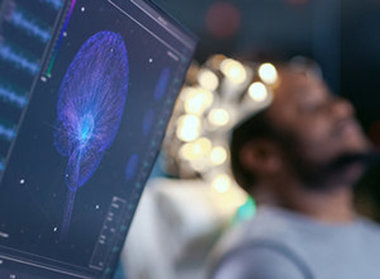How pain looks in the brain
 Our minds and bodies are inseparable, so few illnesses happen in isolation - for example diabetic patients are at a higher risk of developing depression than the general population.
Our minds and bodies are inseparable, so few illnesses happen in isolation - for example diabetic patients are at a higher risk of developing depression than the general population.
When it comes to mental health conditions, people living with generalised anxiety disorder often experience physical symptoms like muscle aches, chest pain and headaches – so is there really a neurological link between emotional state and physical pain?
To learn how pain is experienced in the brain we met with Dr Ryan Patel, a King’s College London Neurosciences researcher who aims to identify the neural circuits that modulate the transmission of pain and its emotional consequences. Dr Ryan Patel's background in neuroscience has given him insight into the workings of neural circuits and pathways, neuroanatomy and the organisation of the nervous system.
What is pain and how does it work?
Pain is a conscious experience and we use pain to guide our decisions and we do this by collecting information on the type of pain we experience – Is it hot or cold? Is it sharp? How intense is it? Where is the pain? Pain is also an emotional experience - it’s unpleasant so we try to avoid it because of the emotional responses that it can cause. Then there's the cognitive influence on pain perception – pain is something we build a relationship with and that’s a relationship that changes over time. Both past experiences and expectations can change how we experience pain.
How do we process pain?
Nerve fibres in skin, muscles and bones detect noxious stimuli which are then relayed to the spinal cord and up to the brain to be processed and experienced as pain. There are also pathways going in the opposite direction - projecting down from the brain to the spinal cord – which gives us with a powerful way of modulating pain transmission. Most analgesics act by manipulating the signal going to the brain, things like paracetamol and local anaesthetics for example which aim to stop pain at its source. Other drugs like opioids and anti-depressants can relieve pain by acting on spinal and brain circuits.
To reduce feelings of physical pain, often during the resolution of injury, pain signalling systems in our bodies can release monoamines, endocannabinoids and endogenous opioids, and its these systems that some analgesics can activate.
Does emotional state affect physical pain?
Stress, for example, can manipulate pain in both directions. In extreme cases it can very temporarily cause analgesia which is a reduced pain response. If you're in an acutely stressful situation and you've suffered an injury, the stress can produce temporary analgesia so you might not realise how injured you are until it starts to hurt a bit later.
It's also entirely possible that chronic stress can exacerbate pain. A shared neuroanatomy might contribute to the reciprocal relationship between pain and emotional state. For example, the regions of the brain implicated in anxiety and depression are also responsible for the processing of pain. Negative emotions are signalled in the same regions of the brain as the aversive or unpleasant nature of pain - particularly the anterior cingulate and prefrontal cortices. But other brain regions like the amygdala and locus coeruleus which are important for processing emotions also regulate our pain sensitivity.
When someone has chronic pain - a pain that doesn't resolve - that takes a big toll on their emotional wellbeing. In these circumstances people can develop anxiety, depression, and insomnia. We know that when chronic pain and mood disorders co-exist, this can exacerbate the experience of both conditions and part of this may stem from a shared neurobiology.